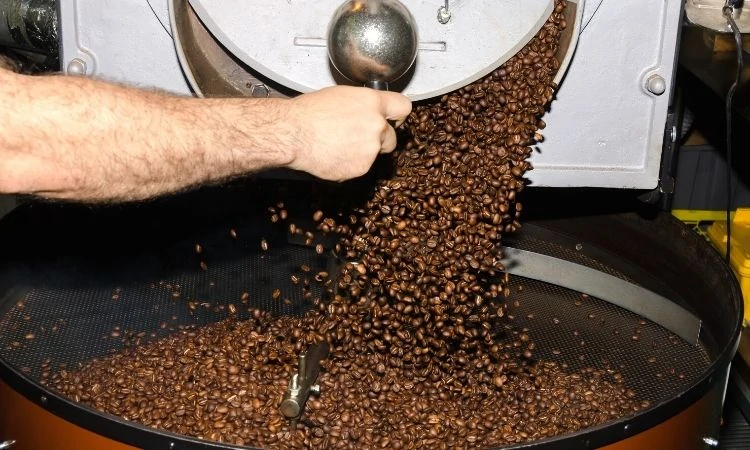Although coffee is loaded with antioxidants and minerals, it can also be an acidic beverage. Acid reflux is no joke, and gastrointestinal upset is never fun!
Since acid is generally associated with heat, you may think that a colder brew would naturally soothe the stomach.
So is cold brew coffee less acidic than hot coffee? Read on to find out!
Is Cold Brew Coffee Less Acidic than Hot Brew?
In short, yes, a cold brew coffee is less acidic than a hot brew in most cases.
This is because the chlorogenic acid (CQA) content is usually lower. However, this is a complex process and there are many factors that affect the acidity of coffee.
Below, we will explain it all in detail.
Types of Acids in Coffee
Coffee contains a few different types of acid. They each have slightly different effects on the body and produce different flavors.
Let’s go over each one of them briefly.
In a nutshell, these are the six most prevalent acids in coffee:
- Citric Acid is most commonly known for having a sour or slightly fruity taste to it. It can be found in fruits like oranges, limes, and lemons. Citric acid plays an important role in the metabolic life of plants. For this reason, it is found in green coffee. When roasted, the citric acid concentration changes in coffee beans. As the roast level progresses, the citric acid levels diminish.
- Acetic Acid is commonly found in fermented liquids. It is produced during two different stages of the coffee production process. This acid is first produced at post-harvest fermentation. Then, it is again produced during roasting. Acetic acid is found in high doses when coffee is wet-processed or barrel-aged. This particular type of acid tends to evaporate during roasting.
- Quinic Acid has a bitter, slightly astringent taste. People who dislike the dryness of coffee are responding to its quinic acid bitterness. It is associated with that roasted, or sometimes, burned flavor. Brewed coffee that sits on the heater too long will develop an unpleasant quinic taste. This is why fresh coffee is considered better tasting.
- Malic Acid is found in fruits like green apples. It has a tart taste and leaves a lingering flavor in your mouth. It is found within the coffee plant itself. For this reason, roasting does not have much of an effect on malic acid. Panamanian Coffee is known for having the most malic acid with notes of apple or pear.
- Phosphoric Acid does not have much flavor. However, it does have an effect on the taste buds. It leaves a sharpness in the mouth that tends to linger. Many people prefer coffee roasts with balanced levels of phosphoric acid. Too little phosphoric acid and coffee can seem bland. Too much, and it has a bite. The longer coffee beans are allowed to ripen on a coffee tree, the last phosphoric acid is likely to have.
- Chlorogenic Acid is often abbreviated to CQA. Robusta coffee beans have twice as much chlorogenic acid as Arabica coffee beans. As such, if you do not enjoy the bitterness of your coffee, check and see if it is a Robusta brew. If so, think about switching to Arabica.
Cold Brew Acidity VS Hot Brew
So what are the levels of acidity when we compare cold brew coffee versus hot brewed ones?
Well, the acidity levels actually depend on what is extracted during the brewing process. Research indicates that the cold brew method produces coffee with less acidity than hot brews. However, the pH levels of hot and cold brews are similar.
This can be complex to understand, but basically hot brews made with the same coffee beans taste more acidic than cold brews.
Let’s go a bit deeper to understand exactly how this works.
Hot brew coffees have higher concentrations of titratable acids. A recent study on the subject found that our perceived intensity of coffee’s sourness correlated poorly with its pH, but strongly with titratable acidity.
So the more titratable acids our cup of coffee has, the more acidic it tastes.
So, although the pH levels can be similar depending on the strength of coffee and the type of coffee used, you will not be able to taste the acids as easily in a cold brew coffee.
What Affects Coffee Acidity?
Coffee acidity can be affected by many factors. The type of coffee plant, growing region, drying process, fermentation, and roast processes will all impact the acidity levels of coffee beans.

Whether one kind of coffee is more acidic than another will mainly depend on these factors:
Origin: The soil, climate, and elevation will all impact the final flavor of the coffee. This includes acidity and its impact on coffee flavors. Coffee grown in a dry climate will often be less bitter than coffee grown in wet areas.
Species & Variety: There are two main coffee varieties. These are arabica and robusta. Robusta coffee is more bitter and acidic than arabica coffee. Within these categories, there are many other varieties of coffee that have different levels of acidity.
Roasting Process: The longer coffee beans are roasted, the less acidic they will be. So, if you don’t like strong acidity, select a darker roast. Although this might seem counterproductive, you will taste the difference.
Brewing Method: Finally, the brewing method impacts acidity. The longer that coffee is brewed or the more intense the extraction process, the less acidic the coffee will be. This is why coffee that is slowly brewed in cold water is less acidic than coffee that is brewed in a coffee maker. Some acids also intensify over time in hot water. This is why coffee that has been on the burner all day tastes so bitter. Finely ground coffee will also be less acidic.
Also, the cold brew coffee to water ratio affects the strength and acidity of the coffee. Stronger coffee will inevitably have more acids.
Is Cold Brew Coffee Less Acidic Than Hot Brew – Final Thoughts
So now you have been filled in on what is the best way to enjoy low acidity coffee.
Basically, the least acidic coffee is a cold brew that is made with dark roasted Arabica coffee beans. Better yet, a dark roasted Arabica coffee that has been dry-processed and freshly prepared.
To put it in simple terms, cold brew arabica coffee is your best bet if you are trying to avoid stomach upset from high acidity.
And you don’t always need to make it yourself. Why not try the Starbucks cold brew made with high-quality coffee beans?

